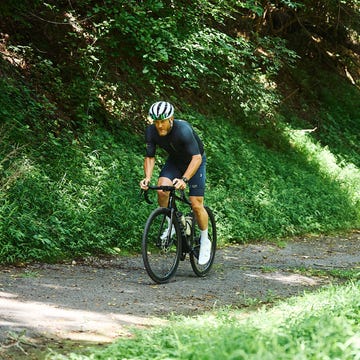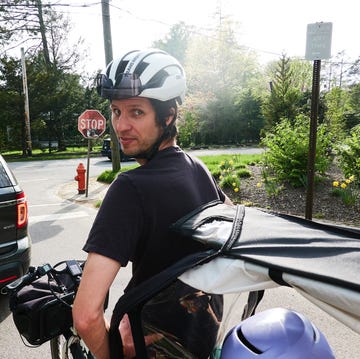Eight years and four generations into its life, the Specialized Levo is one of the best-known and most regarded high-performance e-mountain bikes.
From its beginnings, Specialized took a unique approach with the Levo, and all its e-bikes. Instead of installing an off-the shelf system from Shimano, Bosch, or other well known supplier, Specialized worked with partners to create proprietary Specialized-only e-bike ecosystems.
This gave Specialized more control over the motors, assist modes, and features than most, which is what helped their e-bikes stand out.
The fourth-generation Levo continues with Specialized's in-house development of the key e-bike components that most brands leave to others. It’s also the most comprehensive overhaul of the Levo e-bike family since the original.
I’ve been reviewing Specialized bikes for a long time, and regardless of your opinion about the company, I think it's fair to say that their bikes rarely disappoint. So, I expected the Levo to be good. What I didn’t expect was for it to be this impressive.
Here are 15 aspects of the new Levo that, in my opinion, distinguish it from other excellent e-mountain bikes.
It Might Be My Favorite Mountain Bike
I’ve never considered an eBike a replacement for an unpowered bike. The Levo 4 has me rethinking that position.
Many things about it have me feeling this way (that I will lay out in a future story), but, in short, it is highly refined, quiet, fun to ride, and free of the many nagging annoyances that seem to infect most other ebikes I’ve ridden.
It’s a superb mountain bike first—great suspension, handling, and feel—and also a great ebike. The new motor is brilliant, it has tons of range, charges super quickly, and it is quiet.
I ride mountain bikes because it is the most enjoyable thing I can do, and I also relish the challenge and fitness that riding trails provides. And right now—and some may find this ironic, but I am currently lighter and in better shape than I’ve been in years—there is no bike I look forward to escaping on to the trails with than the Levo 4.
It Is Less Expensive Than the Levo 3
When the Levo 3 launched in 2021, the S-Works version sold for $15,000. In a twist I had not anticipated, the S-Works Levo 4 is $1,500 cheaper.
All Levo 4 models are $500 to $1,500 cheaper than the comparable Levo 3 model, which seems incredible given our current inflation and tariff situation.
Perhaps Specialized knows they can’t charge as much as they want to in light of sluggish sales industry-wide and continued discounting. Whatever the reason, the Levo 4 isn’t cheap, but it’s less expensive than I think anyone anticipated.
The Levo 4 Is Only Offered With a Carbon Frame
At debut, the Levo 4 platform is only offered with a carbon frame. Currently, there is no official information about aluminum models.
However, Specialized’s recent launch format has been to debut a new bike with higher priced carbon models and follow up with the less expensive aluminum models later. The Levo 3 with an aluminum frame’s opening price point was $5,500, and I anticipate that Specialize will eventually have a Levo 4 with an aluminum frame at that price or even less.
It Has a 28MPH/Class 3 Assist Cutoff Option
A Levo 4 purchased in the USA has a menu setting that lets the rider change the assist cutoff from Class 2/20mph to Class 3/28mph. This setting is not sticky and resets to 20mph every time the bike is powered off.
Specialized added this feature because riders pedaling to trailheads—or transferring between trail systems—on surface streets often found themselves bouncing on the 20mph assist cutoff. This is, I can affirm, super annoying.
I have a Levo 4 bike in for review and, as someone who pedals from home to the trailhead on paved streets to the trailhead most rides, the Levo 4’s Class 3 setting is heaven-sent and something I wish more eMTBs offered.
I’m certain some will freak out about an eMTB having a class 3 setting, but I don’t think it will be a problem on trails as I will explain in an article that will publish soon.
The S-Works Model Has the Most Powerful Motor
In a move that I’m surprised didn’t happen sooner—because it is common practice in other genres of powered performance vehicles—Specialized equips the top-of-the-line S-Works model with a more powerful version of its new 3.1 motor.
While all versions of the 3.1 motor are more powerful than the Levo 3’s 2.2 motor (90Nm and 565 watts peak assist), the S-Works Levo 4 motor pumps out 111Nm and 720 watts of peak assist while the standard 3.1 produces 101Nm and 666 watts of peak assist.
Is Specialized’s move a harbinger of brands finding creative ways to charge more for “premium” features in their electronic products? That’s something I discuss in an upcoming story.
No More Belt in the Motor
Previously, full-power Specialized ebike motors (like the one in the Levo 3) employed a belt. At the time, Specialized’s employees said the belt helped reduce motor noise and vibrations, and the Specialized full-power motor was one of the quietest and smoothest available. But the belt was also the most common source of problems.
The new motor has no belt, and Specialized also switched to larger and all all-metal gears. While this insinuates greater durability, it also hints at more noise.
Specialized claims that they took numerous steps to mitigate noise and vibrations, and the new motor is no louder than the old motor, although the tone is different. On the trail, I found the new motor was still very quiet and frequently drowned out by the tire noise and my breathing.
Optimal Cadence for Power and Efficiency Are Now Aligned
Most ebike makers will tell you that their motors operate most efficiently—meaning the most range—if you pedal with a cadence of about 90 RPM.
However, the rider cadence with the most motor efficiency is not necessarily the same as the cadence where a motor produces the most torque.
The Levo 3’s motor produced the most torque when the rider pedaled about 60rpm, with torque decreasing at faster cadences. That meant a rider would sacrifice efficiency to encourage the motor to produce the most power.
The Levo 4 motor's torque peaks at 70 rpm, and crucially, torque remains constant up to 120 rpm. That means riders can enjoy the motor’s maximum torque while also spinning at a cadence that allows the motor to operate most efficiently.
All Levo 4 Models Get an 840Wh Battery
Every model of the Levo 4 Carbon employs the same 840WH in-frame battery. This is a healthy increase from the Levo 3's 700WH battery. The range extender, available aftermarket for $760 (with cable), also gets a small bump from 250WH to 280WH.
It Has In-Frame Storage
Specialized popularized in-frame downtube storage when it debuted SWAT 10 years ago. It’s now a feature incorporated into many mountain, gravel, and even road bikes. But while unpowered bikes have a hollow downtube, an ebike’s downtube is filled with a battery.
But with the new Levo 4, Specialized utilized the small space inside the downtube above the battery to create a hidden storage area, complete with a magnetically secured bag.
It’s not a big space—and sizes S2 and S3 have less space than larger frames—but my S3 review bike had enough room for a butyl tube (or two TPU tubes), two CO2 cartridges and inflator head, and a bit more.
It’s not the easiest to access —you need to remove the battery door and the battery to reach the bag—but it’s a way to take a repair kit without strapping anything to the outside of the frame or weighing down a pack.
You Can Buy a Smaller Battery
Later this year, Specialized will offer a smaller 600 WH battery for the Levo 4 (price TBA). Although this will decrease the Levo 4’s range, it will also reduce the bike's weight by about 4.4 pounds. This is a significant weight reduction, which should make the Levo 4 feel notably more agile.
This smaller battery also increases the storage space inside the frame.
It Can Be Run off the Range Extender Only
If you want the lightest possible Levo 4, remove the in-frame battery and power the Levo 4 from just the 280Wh range extender. In this situation, maximum assist automatically drops by 50 percent, but the whole in-frame battery compartment becomes a huge storage compartment. This is officially supported, too: Specialized makes a rubber shield to protect the battery terminals when the in-frame battery is absent.
The Cranks Are Extremely Short
An eBike motor operates only while the rider is pedaling. Therefore, encouraging the rider to pedal as much as possible is advantageous.
Most Levo 4 models have super short 155mm arms, which offer more ground clearance than a longer arm, allowing the rider to spin over more obstacles.
The S-Works model is the exception. It has 160mm arms only because SRAM does not offer its XX carbon eBike crank arms in 155mm.
Battery Charging Is Speedy*
Big batteries are fantastic because they give you more play time, but the downside is they usually take longer to charge.
When hooked to the Smart Charger (included with the S-Works model, an option, price $600, for other models), Specialized claims the 840WH battery charges from zero to 80 percent in less than an hour.
The claim appears accurate. I drained the battery to zero, connected it to the charger, and with fast charging selected, my bike reached 80 percent in less than an hour. However, topping off the remaining 20 percent takes nearly as long as charging the first 80 percent (a common quirk of high-performance batteries), so my charge from zero to 100 took just under two hours. For an 840Wh battery, that is still remarkably fast.
That’s cool because, with a multi-hour range available from the 840WH battery, the Levo 4’s battery charges faster than you can drain it (in many to most riding situations).
The Motor Doesn’t Derate at Lower Charges
As their battery drains, many ebikes will automatically derate (reduce available motor power). The Levo 3 and other ebikes do this with around 10 to 15 percent remaining charge. This is a safeguard to prevent damaging the battery.
The Levo 4, however, will pump out its full power in all modes until the battery’s fuel gauge reads zero. At this point, the motor power cuts off, but the system continues to power the display and, if equipped with an extension cord, continues to power an SRAM AXS electronic rear derailleur.
Joe Buckley, the Levo’s product manager, states that they can do this without harming the battery because of the new high-voltage architecture employed by the Levo 4. Higher voltage systems allow lower currents, which reduces strain on electrical components.
The Battery Compartment “Breathes”
After a nearly 30-mile singletrack ride on my test bike, I noticed a decent amount of dust in the battery compartment. And if dust can get in, so can water.
When I raised this issue with Buckley, he said, “The frame breathes a bit while riding—It’s not fully sealed. Water gets in the frame between the motor/frame interface, headset, routing ports, etc., so we felt it didn’t make sense to overbuild the door when things get in other ways. When you plug the battery into the receiver, there is a seal that keeps the battery pins sealed.”

A gear editor for his entire career, Matt’s journey to becoming a leading cycling tech journalist started in 1995, and he’s been at it ever since; likely riding more cycling equipment than anyone on the planet along the way. Previous to his time with Bicycling, Matt worked in bike shops as a service manager, mechanic, and sales person. Based in Durango, Colorado, he enjoys riding and testing any and all kinds of bikes, so you’re just as likely to see him on a road bike dressed in Lycra at a Tuesday night worlds ride as you are to find him dressed in a full face helmet and pads riding a bike park on an enduro bike. He doesn’t race often, but he’s game for anything; having entered road races, criteriums, trials competitions, dual slalom, downhill races, enduros, stage races, short track, time trials, and gran fondos. Next up on his to-do list: a multi day bikepacking trip, and an e-bike race.




















